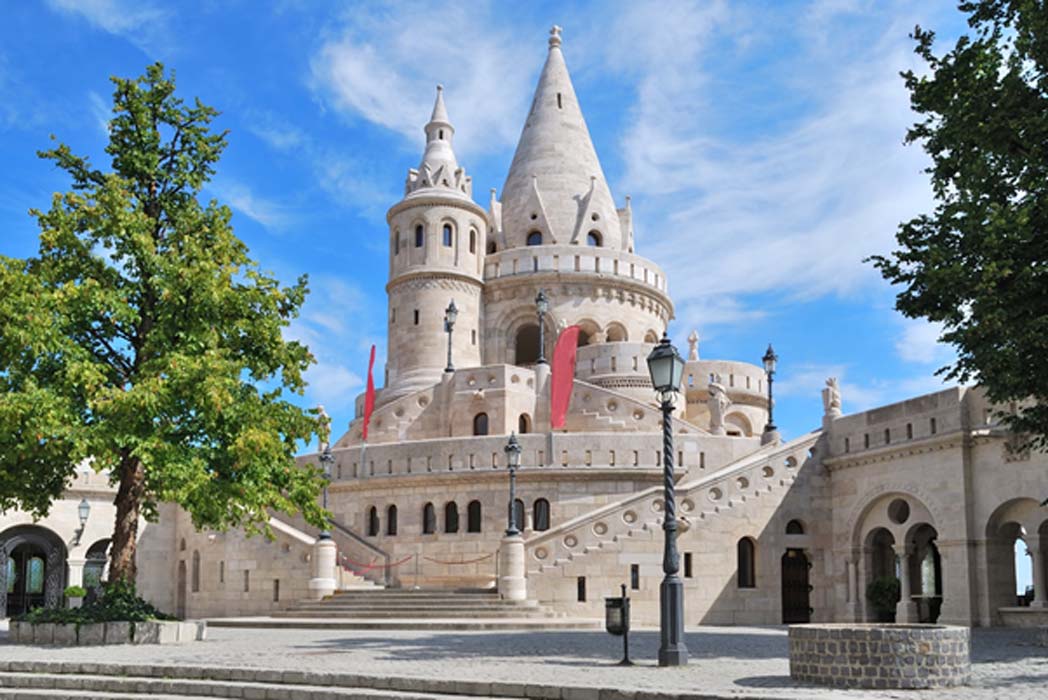Fisherman's Bastion: A Fairytale Tower Commemorating 1,000 Years of Hungarian History
Architect Frigyes Schulek started the rebuild and restoration of Matthias Church in 1873 with the aim of returning it back to its former glory. As part this project, the grounds around Buda Castle, Castle Hill where the church sits, needed to be redesigned to emphasize its beauty. The views of Budapest were incredible from Fisherman’s Bastion but could not be appreciated because the former castle walls and battlements were narrow and cramped. To achieve his vision Schulek, who was inspired by Romanesque and Gothic architecture, redesigned Fisherman’s Bastion at the same time. Today the area is a UNESCO World Heritage site.

St Matthias Church at night (Dmitry Pistrov / Fotolia)
With its panoramic views of Budapest, the Danube River, and its ornate features, Fisherman’s Bastion ( Halászbástya in Hungarian) is one of the most popular tourist destinations in the city. And although the architecture might resemble battlements, the structure wasn’t designed to offer defense - it is a historical monument memorializing the first thousand years of a united Hungary.
The Origin of the Name ‘Fisherman’s Bastion’ is a Mystery
Some claim that this particular part of the walls was protected by the guild of fishermen (halasz), who lived below it in Watertown, between the Danube River and the castle walls. During war time, they would climb up to and help protect the castle; during times of peace, the fishmongers took a shortcut through a little gate to Buda Castle where they sold their produce at the market.
An alternate theory states that the castle’s hilltop fish market next to the Matthias Church gave its name to the Fisherman’s Bastion.
Forgotten Chapel Uncovered
Since Buda Castle was no longer needed for military defense from 1874, the idea was to build something for the citizens to appreciate the great views of their city.
Rather than the limited viewpoints and narrow walkways of the former defensive walls, the new design of the battlements was to be spacious with large arches and wide steps.

The wide steps and viewing arches of Fisherman’s Bastion (horizonphoto/ Fotolia)
Schulek’s concept for the construction was a creation that replicated history, the emphasis being on the dramatic entrance leading up the hills towards Matthias Church. The arrangement was to embrace the church while connecting the castle hilltop with Watertown.
A key aspect of Fisherman’s Bastion is its seven spired towers, which represent the seven founding Hungarian chieftains of the Magyar tribes who controlled the land before it was united as Hungary. In 1906 a statue of St Stephen (Stephen I) riding a horse was erected. As the leader of the seven Hungarian tribes, he was the first King of Hungary from 1000 to 1038.
- One of the Largest Castles in Europe Was Born to Resist the Mongol Invasion
- Discover the Rich History of the Magnificent Portuguese Castle of Obidos
- Mysterious Labyrinth of Buda: Enigmatic Ancient Caves beneath Castle Suddenly and Inexplicably Evacuated by Police

Three of the seven founding Hungarian chieftains (Rocker Stocker/ Fotolia)
During the construction of the Fisherman Bastion, the medieval underground St Michael Chapel was revealed and part of it was incorporated into the Bastion. The chapel was first mentioned in the medieval chronicles in 1443.
Buda Castle Was Attacked and Almost Destroyed Over the Centuries
Built on existing defensive structures that were part of Buda Castle, Fisherman’s Bastion was started in 1895 as part of the millennial birthday celebrations for Hungary, which was founded in 895. Construction only took seven years to complete.
The original thick castle walls were built when the castle was founded by Hungarian kings. In the 16th century it was conquered by the Turks, re-taken by the Austrians, and attacked by Nazi and Russian troops in the 20th century.

Buda Castle on Castle hill, Budapest (cge2010/ Fotolia)
The area has retained this design and structure since its construction, however, during WWII Fisherman’s Bastion was seriously damaged and the restoration of the Neo-Romanesque viewing tower was carried out by Frigyes Schulek’s son, Janos.
While occupied by the Soviets, Fisherman’s Bastion donned a giant red star hanging from the arches that looked out over the Danube. This star could even be seen by everyone on the West side, a constant reminder of the communist rule.
Ultra-Modern Hotel Causes Controversy
The biggest change around the Fisherman’s Bastion came in the 1970s, when the Hilton hotel was built directly behind the towers of the Halászbástya. At the time, it caused a great deal of controversy because the design with its shiny windows and modern technology, which was rarely seen in what was then Communist Hungary, was in contrast with the grandeur of Matthias Church, the Fisherman’s Bastion, and the historical image of the castle.

Johann Ernst Mansfeld Etching of Buda Castle Walls, 1777 (Public Domain)
Budapest is a city best explored with time on your hands as there are numerous things to see and do for those who love history, architecture, and photography. Foodies, market browsers, hikers and bikers, as well as those who’ve dreamt of cruising down the iconic Danube will be in paradise. And at the end of the long pleasure-filled day, relax at Fisherman’s Bastion and look out over magnificent Budapest.
Top image: Fisherman’s Bastion Source: (Noppasinw / Adobe Stock)
References
Barnes, A. 2018. A Guide to Fisherman's Bastion, Budapest. Culture Trip
Available at: https://theculturetrip.com/europe/hungary/articles/a-guide-to-fishermans-bastion-budapest/
Levy, A. 1979. An Exploratory Visit to the First Hilton in Communist Europe. The New York Times.
Available at: https://www.nytimes.com/1979/02/25/archives/an-exploratory-visit-to-the-first-hilton-in-communist-europe.html
Site Author. 2012 . History of Fisherman’s Bastion. Fisherman’s Bastion
Available at: http://www.fishermansbastion.com/history


















Comments
This article wasn’t put together well